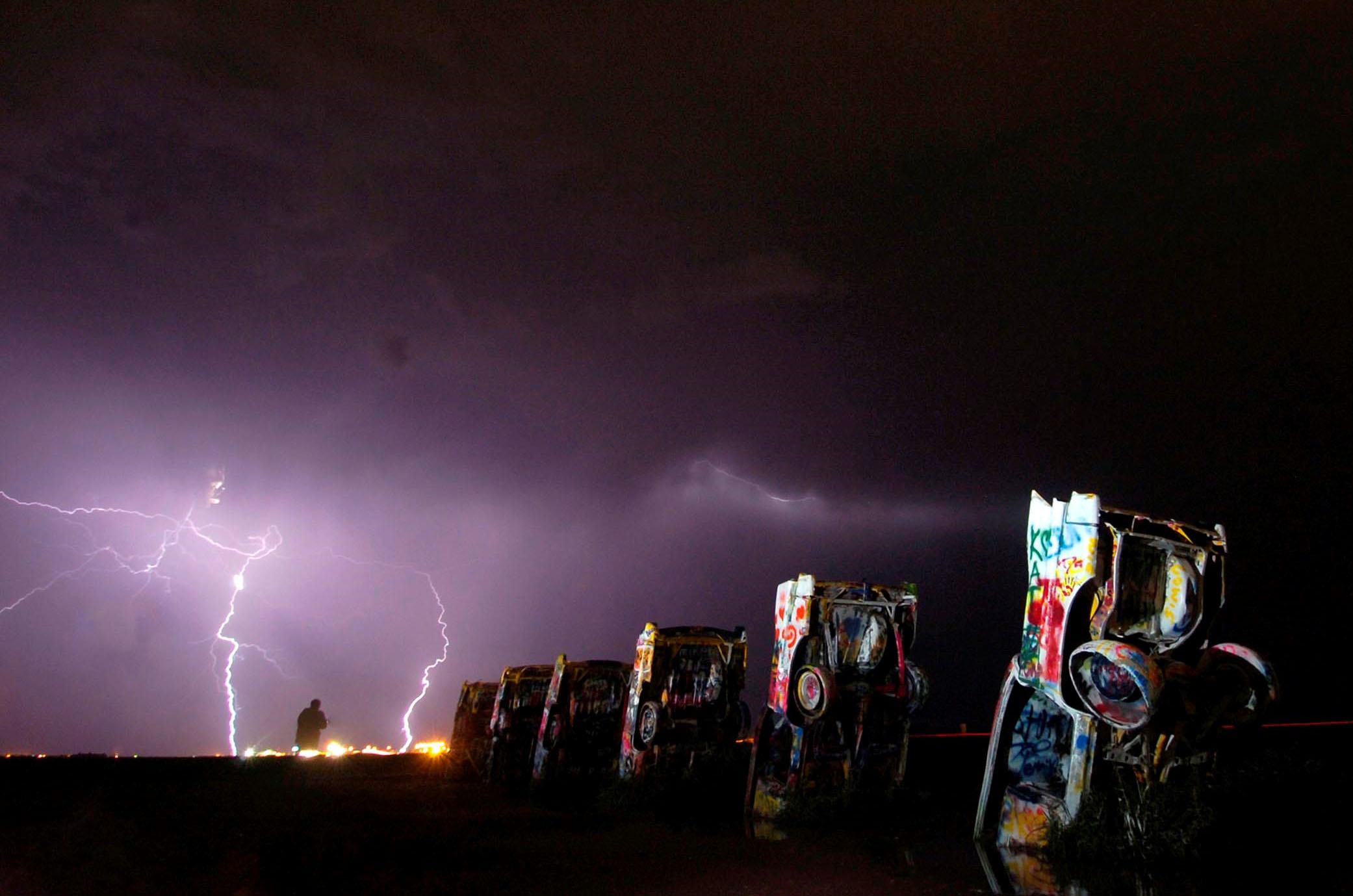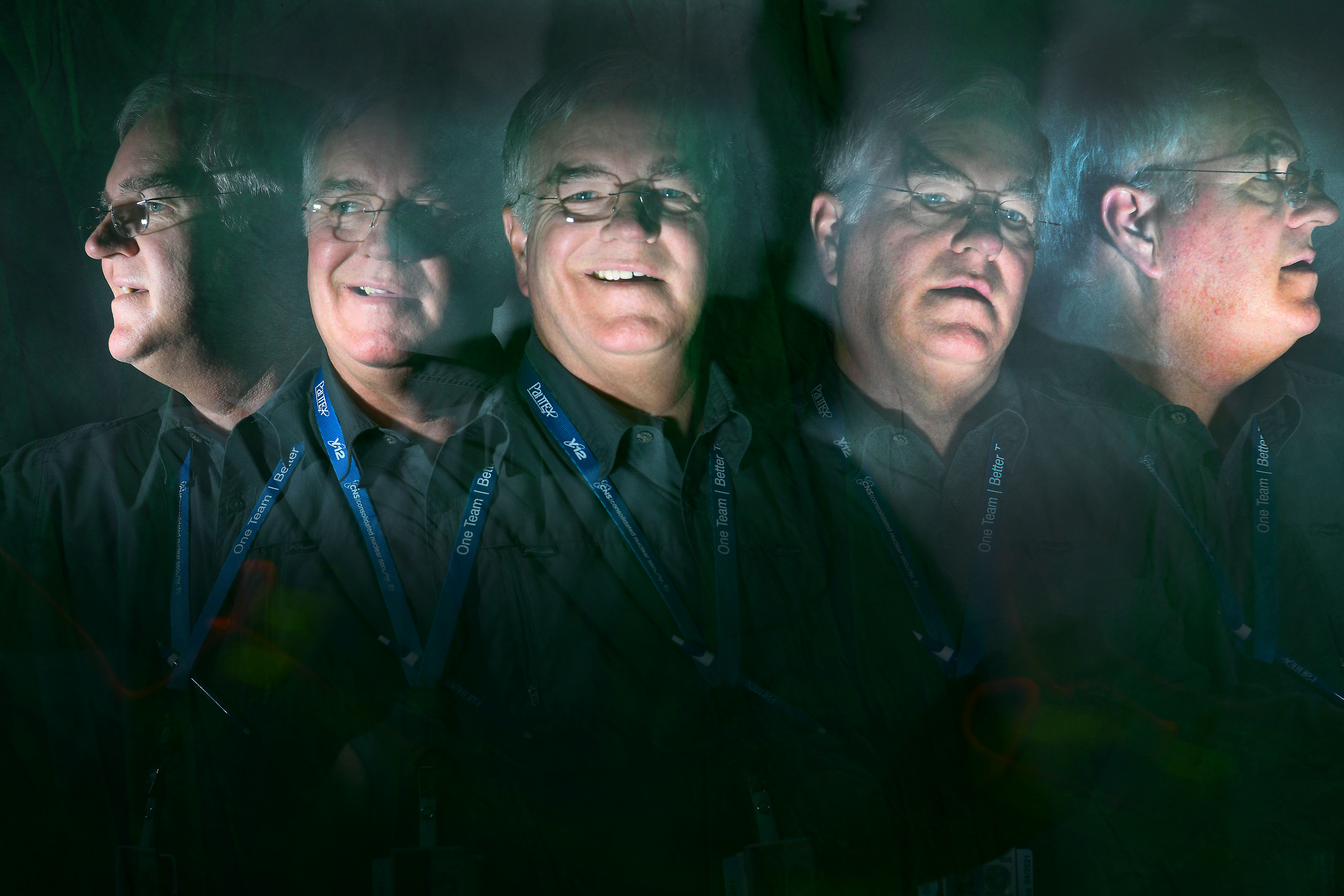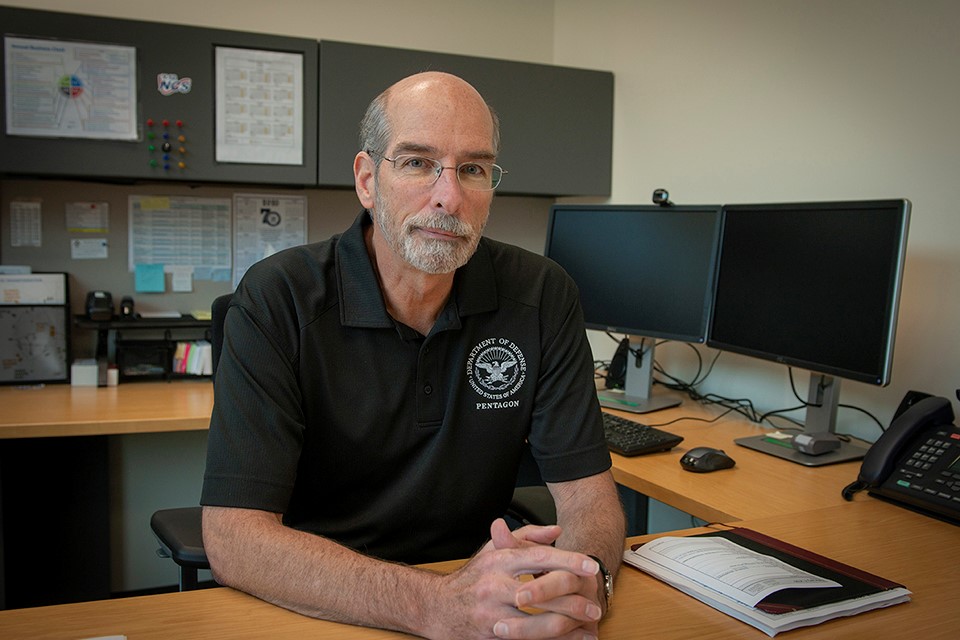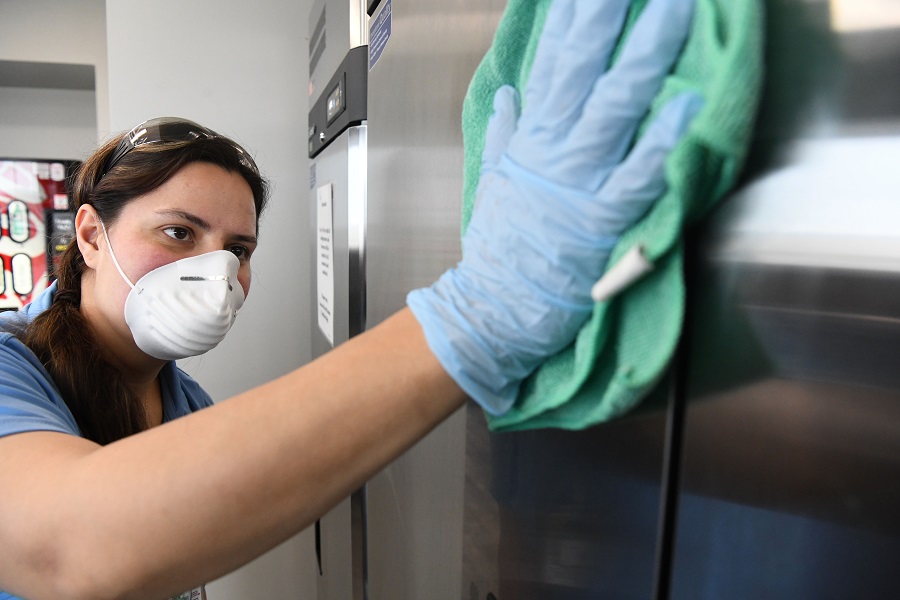Pantex Blog
Behind the lens with Michael Schumacher
|
Electronics Technician Galen Boothe, a 50-year Pantexan, works on a Micro-Plasma Tig Welder in the Electronics Shop |
In honor of World Photography Day, we’d like to introduce you to Pantex Photographer Michael Schumacher.
You may have seen Michael around the plant – he has a camera in tow and a smile on his face – ready to snap photos of the people, places, and events of the Pantex Plant.
Michael has taken photographs since he was a young boy, first learning basic photography, cameras, exposure, and darkroom film processing and printing from his father who was a hobbyist photographer. His first camera was a Kodak Brownie, and he took family snap shots and silly pictures of his feet.
He fell in love with photography while living in Wyoming.
“I caught the photo bug while living in Wyoming with all beautiful scenery around Big Horn, Sheridan, and Yellowstone.”
Michael said he has always wanted to be a photographer and had his first news photo published at the age of 15 – a breaking news story photo of a smashed tricycle.
“After that, I wanted to be a photojournalist,” he said, “so I went to school and began working in the newspaper industry for 35 years at papers in Oklahoma and Texas.”
Most recently Michael spent 20 years at the Amarillo Globe-News before coming to Pantex in 2019. He says he’s photographed a lot of wonderful and amazing people and has seen a lot of bad things he’d like to forget in his career as a photojournalist.
Michael has been married to his wife Shari for 36 years, and they spend their spare time raising Chow Chows.
His favorite part of being a photographer is meeting people and telling their stories in pictures.
“I like to capture personality in a photo and show people somethings they have never seen before,” he said. “I always wanted to be the eyes for a community and make a difference with my photography.”
Michael said one of his favorite things to photograph is lightning.
“It’s so cool looking and unpredictable,” he said. “One summer night I was shooting at the Cadillac Ranch trying to catch meteors from the Perseids Meteor shower which happens every August.”
In the late hours a storm rolled up and went right over the Cadillacs.
“I got several nice pictures of lightning and this one in particular where my silhouette showed up in the frame,” he said. “I always liked that picture and I still thank God to this day for protecting me while shooting pictures in the middle of a wheat field with lightning striking all around.”
Michael has a strong faith and says that God motivates him, but he has admired Ansel Adams’ black and white photography his entire life.
“I was also inspired by many Associated Press photographers for years, especially the Vietnam era shooters,” he said. “Their photos during the war touched my heart and opened my eyes to the power of photography and its ability to change the world.”
Michael’s bucket list for photography includes spending time in Israel.
“The history and people of that area intrigue me,” he said. “I’d love to spend a year documenting the country.”
When asked how his role at Pantex adds to the mission he said “as a Pantex photographer, my goal is to illustrate the day to day operation at Pantex and to tell the great stories about our proud Pantexan workforce through photos.”
Michael said he has the best job in the world.
“I get to meet new people every day, learn cool stuff and tell incredible stories in photos,” he said. “I usually keep a smiley-face sticker on the back of my cameras to remind me to always have fun. If I’m having fun, then everyone around is usually having a good time and it shows in photographs I make. So let’s have fun people!”
Security Police Officer Payten Pearson training at the Pantex Range
Pantex Tool Maker Michael Gover (QC), a 15-year employee, watches the milling process on a Mazak Mill in the Machine Shop

Electric Cadillacs

Selfie fun
I am Mission Success: Laura Valdez
Take five minutes and learn about CNS’s Laura Valdez, Quality Projects and Programs. “I am mission success” profiles share how each employee feels tied to the Pantex and/or Y‑12 mission. All views and opinions are the employee’s own and do not necessarily reflect those of CNS.
|
Laura Valdez, Quality Projects and Programs. |
With 27 years of experience at Pantex, Laura Valdez has a passion for doing things well. This has made her job in Quality Projects and Programs the perfect fit for the last ten years.
“I enjoy instilling quality in our mission. Even more satisfying is witnessing the same passion in others for quality and for making sure what we do is the right thing and for the right reasons,” she said.
Laura graduated from Caprock High School in Amarillo, Texas and never dreamed she’d be working at Pantex. Attending West Texas A&M University, Laura earned both undergraduate and masters degrees in accounting. She began working at Pantex as a budget analyst. Since then, she has worked in Projects, Program Management, and now Quality. The experience and knowledge gained from each area has paved a path to her passion for what we do at Pantex and for doing what is right.
What is your favorite aspect about your work environment? How does that aspect make you know the mission is being met?
The role I am in now is very gratifying because Quality touches every aspect of what we do at both sites. I have the opportunity to work with many different organizations and processes. I’m also in a position to affect change, whether it’s from a continuous improvement perspective or responding to an issue. I view our role as the conscience of the company, which carries with it a great responsibility to ensure not only that we meet our mission, but that we do it right.
Are you doing what you envisioned as a young adult?
No. I knew I wanted to be an accountant from an early age; and, at the time, never saw myself as doing anything else. The significance of what we do at Pantex means so much more to me now than when I was younger or even when I first started working here.
Although my education is in accounting, I have been able to move into positions that helped me grow and learn. I never would have thought I’d be doing what I do now. I’ve been in this position for ten years, the longest I’ve been in any position here.
As an employee, what do you want to be remembered for?
I want to be remembered as a person who isn’t afraid to speak up for what is right. Those who know me know that I speak my mind; and, when I do, it’s always from a good place. I’ve seen what can happen if someone doesn’t speak up, and I don’t want to be the one who stood by and let something happen because I said nothing. I am that way at work and at home.
I am also someone who will volunteer where I see a need and have a hard time saying no when asked to help. I hope I am remembered as a person who helps others.
What work advice would you offer someone who is new to Pantex or Y-12?
Don’t hesitate to offer suggestions for improvement. Ask questions. A new set of eyes and perspective on processes are an important aspect of a learning organization.
Another bit of advice that I feel strongly about is to learn as much as you can about different functions at work. Don’t limit yourself or hesitate to try something new. Pantex is a great place to do that, because you have the opportunity to move into other positions and build on your experience and knowledge base. It can be very rewarding personally, especially as it increases your contribution to the organization and our success.
What’s your favorite outside-of-work activity?
I spend a lot of time with my family. My husband, Jason, and I have been married for 21 years and have two children. Madison is 13 and Alex is 16. I enjoy being involved in their school and sport activities. I recently coached my daughter’s club volleyball team and will be helping coach her team at Holy Cross Catholic Academy this year.
Helping our neighbors: Pantex in the community
Sixteen nonprofits in the Texas Panhandle will be better able to expand or continue their missions thanks to grants from Consolidated Nuclear Security’s (CNS) Pantex Community Investment Fund, administered by the Amarillo Area Foundation (AAF). On June 25, AAF and CNS Pantex hosted a virtual grant ceremony to award the following organizations:
Nonprofits receiving grants:
- A World for Children – $5,000
- Amarillo Area Court Appointed Special Advocate – $7,500
- Amarillo Children’s Home – $10,000
- Another Chance House – $7,500
- Faith City Mission – $6,000
- Family Care Foundation – $6,000
- Heal the City Free Clinic – $6,000
- Hope Lives Here – $6,000
- Make‑A‑Wish Foundation of North Texas – $7,500
- Martha’s Home – $10,000
- Ronald McDonald House Charities – $10,000
- Sharing Hope Ministry – $10,000
- Texas Ramp Project – $5,000
- The Downtown Women’s Center – $7,500
- Turn Center – $10,000
- Upbring – $7,500
Earlier in June, High Plains Food Bank asked for volunteers, and Pantexans answered that call. On June 12, 10 Pantexans helped sort and pack at the HPFB warehouse. The HPFB partners with over 190 different agencies to help end hunger in the Texas Panhandle. Before the pandemic, HPFB was distributing more than 6,000,000 meals each year. The food bank’s goal during the COVID‑19 crisis is 2,000 meals daily.
I am mission success: Gary Sanders

Mission Engineering is led by Gary Sanders, who has a wealth of experience within the nuclear weapons complex. |
Gary Sanders has led a unique and distinguished career, including stops at the Pentagon and the U.S. Department of Energy Headquarters, where he interacted with top defense brass and foreign nuclear agencies. However, as a child, he aimed higher.
“I always wanted to be an Air Force pilot,” Sanders recalled, “but they wouldn’t let me fly because of my vision.” Instead, he pursued a new path — nuclear engineering and reactor design.
“I never could have predicted all the opportunities I have had,” said Sanders, whose opt in attitude has kept him on the go. An engineering internship at Bettis Atomic Power Laboratory led to graduate school and Sandia National Laboratories, where he helped design the nuclear weapons that Pantex and Y-12 maintain and refurbish today. Fewer than 12 years after starting his career, Sanders had his first special assignment in Washington, D.C., which eventually resulted in multiple assignments with the Air Force.
“I still didn’t get to fly their planes, but I did get to improve the safety features of their nuclear weapons.”
Before joining CNS, Sanders and his wife thoroughly enjoyed two years of retirement. “We’d alternate between visiting mountains and beaches,” he recalled, noting that outside of work he likes to scuba dive and hike. “I also volunteered at the aquarium and really enjoyed raising multiple litters of puppies for the local animal shelter,” Sanders said.
Why are you mission success, and how was it proven during the sites’ reduced, mission critical operations?
Mission Engineering enables Pantex and Y-12 Operations. Production equipment must work, project teams need to be able to do their updates, nuclear safety has to be in place, and so much more. The sites literally cannot do their mission without us, and we are useless if they can’t use what we design and build.
During the reduced, mission critical status, the importance of Mission Engineering was proven yet again: Approximately 80% of the Pantex work to build and surveil weapons continued, and we had teams set up to help with their Safety Basis, tools and procedures. Virtually all of the Development work continued as mission essential, including work on purifying uranium, melting binary, performing readiness assessments of lithium technology, and much more. All Engineering support for the Uranium Processing Facility continued across multiple shifts, and most project engineering support continued, including using computer-aided design to perform designs from home.
How did your opinion of your work environment change as CNS sites were placed in reduced, mission critical status? What is your favorite aspect about your work environment?
The flexibility to perform a large degree of engineering design work remotely has been eye opening and only made possible by the heroic support of Information Solutions and Services. I believe teleworking will permanently change some of how we do business in the future to accommodate family dynamics.
As for my favorite aspect, hands down, it is not having to wear a suit and tie. I wore both for years in Washington, D.C., while working at the Pentagon. I brought only one suit with me when I moved to Tennessee.
As an employee, what do you want to be remembered for?
I can think of two things. First, asking two important questions: Why are we doing it this way, and can we do it better? And second, for reinforcing educational standards for Pantex and Y-12 Engineering positions. An engineering degree denotes a level of technical rigor that must be in place for certain aspects of our work.
What work advice would you offer someone who is new to Pantex and Y-12?
Be open to experiences and challenges — they will both come, and both provide opportunities. Also, visit or transfer between the sites. It’s important to understand the people and challenges at both locations.
What one thing would your coworkers be surprised to know about you?
I was not raised in the United States. My father worked for U.S. Steel, which took us to Puerto Ordaz, Venezuela, where I grew up.
The frontline cleaning‑up COVID‑19
 Y-12 Building Services and Lawler-Wood Maintenance and Facilities Technicians continue to disinfect commonly used areas and ensure their safety using face masks and gloves. |
When the presence of COVID-19 approached our corner of the world, causing many to brace for impact, Pantex Utilities and Maintenance, Y-12 Building Services, and Lawler Wood Maintenance and Facilities technicians at both sites were called to action. As the first line of defense against germs on site, these professionals are responsible for contributing to the overall health of employees especially during viral seasons. Only this time, they were courageously working against a different and unknown pathogen.
Armed with a dedicated task force, N95 respirators, gloves, goggles, and other necessary personal protective equipment, teams have worked quickly and diligently over the course of the outbreak to sanitize surfaces and spaces throughout Pantex and Y-12 facilities.
“We have a very professional team of building services employees who take safety very seriously,” said Y-12 Building Services Supervisor Nate Criswell. “In addition to our routine best practices, we discussed the virus more in depth and shared as much information as we could get our hands on in regards to emerging best practices as it relates to cleaning, PPE, and hygiene.”
Increased cleaning duties to twice a shift, along with the everyday janitorial duties, made for long days and even some extra hours on the weekends to maintain 24/7 operations.
“Our team performed at a high level,” Johnny Heredia, Pantex Infrastructure specialist, said. “The whole department was focused on the same goal: not getting anyone sick. We sometimes changed what we were doing in order to achieve the goals in an even more effective and efficient manner. Our team adapted and has stepped up our activities to maintain productivity.”
Already ahead of the curve in terms of safety processes and equipment, there weren’t many standard precautions for the building services team to take that weren’t already in place. Through team briefings, crews were refreshed on the differences and processes for cleaning, sanitizing, disinfecting, choosing the right chemicals for the job, and using correct PPE at all times. With plans drawn and scheduled, personnel were ready to eliminate the wake of the virus.
“Early on, our team was asked to respond to situations where employees were being sent home with symptoms or had been confirmed to have the virus,” Criswell said. “Through preparation, knowledge, and having the proper PPE, our teams deployed out to these responses more confident in the fact that they were protected and they knew the best ways to treat these areas to prevent further spread.”
As attention was directed to slowing the spread, crews began expanding to common zones, offices, breakrooms, waiting areas, etc. At the John C. Drummond Center, Lawler Wood Pantex also took advantage of reduced personnel onsite to deep clean areas such as air filters, windowsills, elevator shafts, and floors.
Throughout Jack Case Center and New Hope Center, Lawler Wood Y-12’s first, second, and third shift crews performed efforts beyond routine deep cleaning.
“Lawler Wood Y-12 employees have worked tirelessly 24/7, often overtime, to respond to requests for additional deep cleaning and disinfecting areas,” said Lawler Wood Y-12 Facility Manager Vicky Bowling. “We greatly appreciate these efforts.”
For Y-12 Building Services, members were divided into teams of two using Clorox 360 equipment. One person to help set up the area and direct the disinfectant cord, and one person to spray. This resulted in an efficient process to cover more ground. Successful disinfection sweeps were completed when all requested areas were sprayed, labeled, dated, and closed.
“I have continuously reminded my folks that what they do day in and day out matters more than they know,” Criswell said. “We are working tirelessly to keep our work family and our nation’s valuable nuclear workers safe and healthy.”
Fearless and focused, both teams remained dedicated to the safety of the mission by taking pride in the details of their work. All the while, knowingly protecting the site’s most precious assets — its people.
“Thank you to who are putting in long days to make sure we have access to the necessities during an immensely challenging time,” Heredia said. “We know you are doing crucial work, and we appreciate you. We couldn’t get through this without you.”

Mandy Miller of Lawler Wood Pantex cleans and disinfects the breakrooms in the JCDC.
